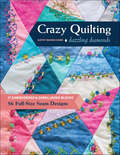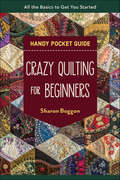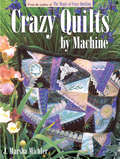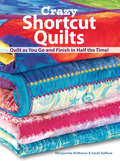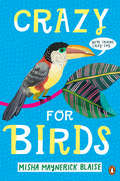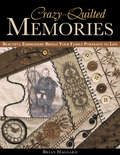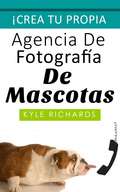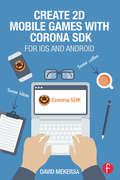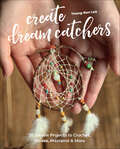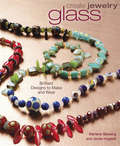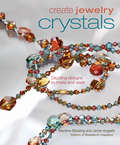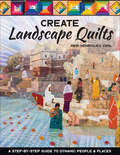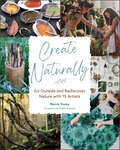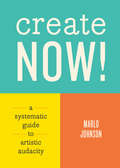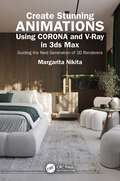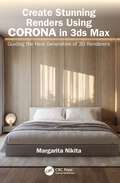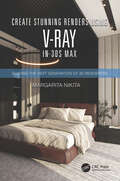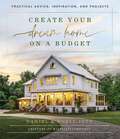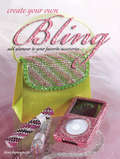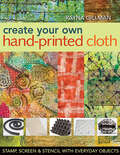- Table View
- List View
Crazy Quilting Dazzling Diamonds
by Kathy Seaman ShawCreate a crazy quilt from start to finish Gather your fabrics … start your machines! The Dazzling Diamonds crazy-quilt pattern is ready for your creative interpretation. One block at a time, you’ll construct twenty-seven crazy-quilting diamonds on foundation-piecing templates. With photos and step-by-step instructions, you’ll have fun embroidering the seams and adding embellishments to your unique masterwork! This pattern comes complete with an embroidery stitch guide and full-size pattern pieces, plus examples of the finished quilt in two colorways. Make a spectacular crazy quilt with foundation piecing Add the “wow” factor with embroidery details, one seam at a time Take the guesswork out of crazy quilting with step-by-step instructions for making the blocks
Crazy Quilting for Beginners Handy Pocket Guide: All the Basics to Get You Started (Pocket Guide Ser.)
by Sharon BoggonCrazy quilting basics to get you started Rooted in the Victorian era, crazy quilting has a powerful allure for today's quilters, who use it to let loose and tell a unique story with fabric. These quilts are as beautiful as they are intimidating to beginner quilters — how do you know which fabric to choose and what in the world is a herringbone stitch? This beginner's guide covers all the basics — but just the basics! — to get you started on crazy quilting. Trained in fine arts, Sharon Boggon guides you through choosing fabric and introduces piecing methods for crazy-quilt blocks and solutions to common piecing problems. You’ll then navigate Boggon’s generous overview of foundation stitches, linear stitches, and motif stitches. Move forward in your crazy quilting journey with confidence, and use this handy pocket guide as a robust resource to lead the way! Easily make embellishing decisions, including lace, ribbon, braids, and doilies Learn how to correctly start and finish stitches Start your project knowing how to mark the fabric and decorate seams, and combine stitches with a gallery of images by your side
Crazy Quilts by Machine
by J Marsha MichlerCreate a Breathtaking Heirloom Known for their lavish embellishment, bold colors, and refined composition, crazy quilts are Victoriana at its best. Crazy quilts are traditionally pieced and embellished with hand methods, but now you - regardless of your skill level - have an all-in-one resource for creating crazy quilts solely by machine or by combining hand and machine methods. Besides providing four machine piecing and patching methods, this lavishly illustrated volume includes: An encyclopedia of machine embellishments suitable for any machine that will do straight and zigzag stitches Complete instructions for 20 original, unique crazy quilted projects Designs for bed, wall, and children's quilts, throws, table covers and pillows Full-size templates
Crazy Shortcut Quilts: Quilt as You Go and Finish in Half the Time!
by Marguerita Mcmanus Sarah RaffuseThe quilt-as-you-go technique in Crazy Short-Cut Quilts eliminates intimidating quilting steps, and empowers sewers with the ability to create full quilts, in no tome, that accent any existing decor. This book provides sewers with time estimates for each step of a crazy quilt patter; demonstrates how to break projects down into manageable pieces and suggests alternate uses for leftover fabrics; and teaches sewers how to make savvy fabric selections to coordinate with existing room or to add new flair.
Crazy for Birds
by Misha Maynerick BlaiseAn exuberant and vibrant illustrated exploration of birds and our relationships with themFrom the Common Swift, which can stay in the air continuously without landing for up to ten months at a time, to the tiny Goldcrest, Europe's smallest bird, which can lay a clutch of a dozen eggs in two weeks totaling one-and-one-half times its body weight, the class of animals we call birds is filled with incredible feats of beauty, intellect, and wonder.With enthralling facts, humorous anecdotes, and gorgeous artwork, artist Misha Blaise pays loving homage to these amazing beings that populate our skies and share the planet with us. Using her own adoration of birds as a starting point to explore avian minutiae both strange and fascinating, Blaise winds through the interconnectedness between humans and our feathered friends, from the eccentric people who obsess about birds to the compelling ways people have integrated birds into culture throughout history, as well as our similar behaviors, kindred intelligence, and shared habitats.Thoughtful, philosophical, and delightful, Crazy for Birds pairs beautiful artwork with whimsical writing to explore the many wonders of birds, shedding light on our abiding connection with nature, the diversity of life, and the idiosyncrasy of the human psyche.
Crazy-Quilted Memories: Beautiful Embroidery Brings Your Family Portraits to Life
by Brian HaggardTurn family photos and mementos into quilted scrapbooks with this crazy quilting guide featuring 10 projects and 24 embroidery stitches.In Crazy-Quilted Memories, quilt artist Brian Haggard shows readers how to turn treasured family keepsakes—including photo prints, buttons, beads, and other keepsakes—into meaningful quilt embellishments. He offers a fresh take on traditional crazy quilt techniques, as well as 24 basic and combination embroidery stitches to create never-before-seen motifs. Each of the 10 projects featured in this volume will tell a story about your life and family history in unique and creative ways. Lovingly stitched by hand, these small, portable projects are destined to become prized family heirlooms for generations to come.
Crea tu propia agencia de fotográfia de mascotas
by Kyle Richards Macarena Daniela Bunster SotoEste libro detalla paso a paso para desarrollar tu propia empresa en el área de la fotografía de mascotas. Dentro de los aspectos más importante destacan el establecimiento de una empresa, marketing ypor su puetos las tpecnicas de fotografía.
Creando la baraja de tarot de Mantegna Tarocci
by Olga Kryuchkova Elena KryuchkovaEste libro incluye la descripción de las cartas de la baraja medieval de Mantegna Tarocci. Cada carta tiene su descripción. El libro tiene una sección en la cual hay imágenes en blanco y negro para colorear. El lector puede colorear las cartas, otorgarles energía, escapar de los problemas del día a día, desarrollar su creatividad. Luego de pintar las cartas las puede pegar en cartón (o el material deseado) para así tener una baraja única de cartas, las cuales puede usar en su vida diaria. Este libro está destinado a una amplia audiencia con interés primario en la adivinación de las cartas de tarot.
Create 2D Mobile Games with Corona SDK: For iOS and Android
by David MekersaCorona SDK is one of the most powerful tools used to create games and apps for mobile devices. The market requires speed; new developers need to operate quickly and efficiently. Create 2D Mobile Games with Corona SDK gives you the tools needed to master Corona - even within the framework of professional constraints. A must-read guide, this book gives you fast, accurate tips to learn the programming language necessary to create games. Read it sequentially or as an FAQ and you will have the tools you need to create any base game before moving on to advanced topics. The tutorial-based format: Contains step-by-step directions complete with coding and screenshots Is filled with tutorials, tips, and links to useful online resources Includes a comprehensive companion website featuring online exercise files to practice coding, full build samples from the text, additional book details, and more!
Create Dream Catchers: 26 Serene Projects to Crochet, Weave, Macramé & More
by Young-Ran LeeExplore traditional Native American charm String together peaceful dream catchers with Korean artist Young-Ran Lee. Each of the 26 projects features a distinctive look and part of the fun is you can find your supplies and materials by just walking through nature. From the beach to the woods, or just your backyard- use shells, leaves, and more for a one-of-a-kind look. Plus, try your hand at crocheting and weaving with more traditional materials like yarn and string for a finished, modern interpretation. Learn about the origins of dream catchers, comprehensive how-to instructions, and enjoy stunning, ethereal photography on each page. Make the most of your materials! Each dream catcher features a unique look from shells, driftwood, seaglass, yarn, beads, feathers, and much more Step-by-step instructions include gorgeous nature photography Practice a variety of techniques like crochet, weaving, macramé, and more
Create Jewelry - Glass: Brilliant Designs to Make and Wear (Create Jewelry Ser.)
by Marlene BlessingJewelry makers and beaders love working with glass beads for their versatility, affordability, and ability to be used in a combination of techniques. Glass beads can add a subtle shine to a jewelry design or take center stage. From tiny seed beads to eye-catching lampwork beads, glass takes many forms - clear, transparent, opaque, vibrantly colored, shiny, or matte.Included in Create Jewelry: Glass are 21 stunning projects ranging in difficulty from easy stringing pieces to more involved seed-bead weaving designs. All projects are glamorous and timeless and represent unique ways to use glass beads in jewelry designs for necklaces, bracelets, and earrings. Innovative designs are combined with intriguing anecdotes, history, and tips about these beautiful beads. Try your hand at a range of techniques, including stringing, wireworking, knotting, and bead weaving and stitches such as ladder stitch, brick stitch, tubular herringbone stitch, square stitch, peyote stitch, and more. Step-by-step instructions that are easy to follow, plus thorough materials lists. Projects are divided into Classic, Special-Occasion, and Fashion-Forward categories, so readers can easily find designs of their choosing. Additional sidebars of interest include the history of glass, glass bead-making techniques, and entertaining tidbits about these specialty beads.From sassy, elegant, dressy, or flirty, Create Jewelry: Glass gives beaders exciting ideas with stunning designs that are both easy and challenging, and that can be created anywhere!
Create Jewelry Crystals: Dazzling Designs To Make And Wear (Create Jewelry Ser.)
by Marlene Blessing Jaime HogsettWith projects ranging in difficulty from easy stringing pieces to more challenging seed bead weaving designs, this guidebook provides 20 stunning crystal designs with expert instructions. Explaining details on the basics of crystal crafting while revealing entertaining tidbits about this specialty bead, crystal jewelry projects are presented for any type of fashion, from classic looks and special occasion pieces to trendy, fashion forward designs. With a variety of glamorous projects - including a rich paisley brooch, a violet and topaz tapestry bracelet, or a midnight blue multistrand necklace for day or evening - crystal lovers will delight in this crafter's companion.
Create Jewelry Pearls: Luxurious Designs To Make And Wear (Create Jewelry Ser.)
by Marlene Blessing Jaime HogsettThe editors of Beadwork magazine reveal the elegance of pearls with projects, photography, and history in this tribute to nature's iconic gemstone. Step-by-step instructions for 20 stunning projects involving natural, freshwater, and imitation pearls are accompanied by photos to guide jewelry makers of all ability levels through the wide range of materials, colors, and shapes used in these elegant and wearable designs. Broken into three sections, "The Classics" covers traditional pearl stringing and simple earrings, "Special Occasions" includes a striking copper-colored choker and a lariat suitable for a bride, and "Fashion Forward" contains a bangle with fiery-colored pearls and a dramatic bracelet using handmade beads and dyed pearls. Chapters on the science and culture of pearls include tips on selecting, working with, and caring for these treasures, while engaging anecdotes and vibrant images of pearls throughout history round out this informative and entertaining book.
Create Jewelry Stones: Stunning Designs to Make and Wear (Create Jewelry Ser.)
by Marlene Blessing Jaime HogsettAdd a few or many semiprecious stones to jewelry designs-turquoise, amethyst, jasper, or onyx or any of the stones commonly available today-to punctuate or entirely shape the look and feel of a piece. From sassy, elegant, dressy, or flirty, Create Jewelry: Stones presents twenty-three projects ranging in difficulty from easy stringing pieces to seed bead weaving designs. All projects are glamorous and timeless and represent unique ways to use stones in jewelry designs for necklaces, bracelets, and earrings. The authors combine innovative designs with intriguing anecdotes, history, and tips about these multifaceted beads. Following in the footsteps of Create Jewelry: Pearls and Create Jewelry: Crystals, Create Jewelry: Stones presents stunning designs, all incorporating various semiprecious gemstone beads.Projects are divided into Classic, Special-Occasion, and Fashion-Forward categories, so readers can easily find designs of their choosing. Beautiful photos are accompanied by step-by-step instructions that are easy to follow, so readers can re-create their own designs. Additional material of interest for stone lovers includes stone basics, the differences between semiprecious and precious stones, entertaining tidbits about these specialty beads, and more.
Create Landscape Quilts: A Step-by-Step Guide to Dynamic People & Places
by Meri Henriques VahlDiscover how to quilt realistic people and places with artistic flair with this informative step-by-step guide. Create unique art quilts of your favorite places―and the places you want to go! Meri Vahl shares her simple yet unique method for quilting realistic nature scenes and villages from fabric. Using photographs from her travels, the author explains how to achieve stunning scenery with lifelike details. With techniques like fabric collage and tulle overlay, even beginners will learn to quilt majestic mountainscapes, charming buildings, and realistic people. A stunning gallery of quilts―some named best in the world―will inspire you to bring your own travel photos and art quilt ideas to life. · From photo to art quilt! Recreate landscapes, people, and buildings with ease · World-renowned art quilter Meri Vahl teaches you her award-winning process · Immortalize your journeys as you paint scenes with fabric, one step at a time
Create Naturally: Go Outside and Rediscover Nature with 15 Artists
by Marcia Young15 makers present personal stories of how nature inspires and enhances their creativityFor artists and crafters of all levels who look for inspiration in natureStories and projects help you find ways to connect to nature with your own works
Create Now!
by Marlo JohnsonThe road to unfettered creativity begins here! Written in an engaging choose-your-own-path format, this unique guide transforms the creative process into a simple series of multiple-choice questions and answers. The journey begins with a simple question designed to spark inspiration: Do you have a clear vision of what you would like to create and why? Whatever the answer, creative coach Marlo Johnson offers the encouragement and guidance needed to move on to the next step. With tips for overcoming blocks, staying motivated, and even sharing finished work with the world, Create Now! is an invaluable tool for artists, writers, and creatives, whether established or aspiring.
Create Now!: A Systematic Guide to Artistic Audacity
by Marlo JohnsonThe road to unfettered creativity begins here! Written in an engaging choose-your-own-path format, this unique guide transforms the creative process into a simple series of multiple-choice questions and answers. The journey begins with a simple question designed to spark inspiration: Do you have a clear vision of what you would like to create and why? Whatever the answer, creative coach Marlo Johnson offers the encouragement and guidance needed to move on to the next step. With tips for overcoming blocks, staying motivated, and even sharing finished work with the world, Create Now! is an invaluable tool for artists, writers, and creatives, whether established or aspiring.
Create Stunning Animations Using Corona and V-Ray in 3ds Max: Guiding the Next Generation of 3D Renderers
by Margarita NikitaThis book is a step-by-step guide on how to create realistic animations using Corona and V-Ray within 3ds Max. It caters to beginners and intermediate users, helping them transform static renders into dynamic and captivating animations. It combines technical knowledge with practical examples, covering everything from basic principles to advanced techniques.By the end of this book, readers will: Understand the fundamentals of animation in 3ds Max Learn to animate cameras, objects, and lights effectively Create realistic animated scenes using Corona and V-Ray Explore time-saving workflows and rendering optimization tips Develop a polished animation portfolio ready for professional projects This book is structured as a nuts-and-bolts how-to guide, breaking down complex animation techniques into manageable steps. Each chapter focuses on a specific aspect of animation, blending foundational knowledge with advanced tips to enhance the reader’s understanding and capability. Through detailed explanations, visual examples, and step-by-step tutorials, this book aims to demystify the animation process for beginners while offering advanced insights for experienced users.
Create Stunning Renders Using Corona in 3ds Max: Guiding the Next Generation of 3D Renderers
by Margarita NikitaThis book is a comprehensive step‑by‑step guide tailored for designers seeking to elevate their visualization skills using the powerful combination of Corona 11 in 3ds Max 2024.It begins by acquainting readers with the 3ds Max interface and fundamental commands, ensuring a solid foundation for navigating the software. Readers will be guided through the process of assigning Corona and fine‑tuning rendering settings, setting up cameras, and mastering both natural and artificial lighting techniques within their scenes.It then progresses to the creation of materials, their application to the scene, and the utilization of Corona’s libraries and presets for efficiency. The potentials of Corona are detailed using a bedroom scene as an example. This practical guide demystifies the complexities of 3D rendering without delving into modeling techniques.With design studios increasingly incorporating 3D renderings into their proposals, Create Stunning Renders Using Corona in 3ds Max: Guiding the Next Generation of 3D Renderers serves as an invaluable resource for professionals and aspiring renderers alike. It aspires to contribute significantly to the evolution of the next generation of 3D rendering artists, making it an essential companion for those eager to master the art of photorealistic renderings in the dynamic landscape of 3ds Max and Corona 11.
Create Stunning Renders Using V-Ray in 3ds Max: Guiding the Next Generation of 3D Renderers
by Margarita NikitaCreate Stunning Renders using V-Ray in 3ds Max: Guiding the Next Generation of 3D Renderers is a step-by-step guide on how to create realistic renderings using V-Ray in 3ds Max. The potentials of V-Ray are detailed using a bedroom scene as an example. The book introduces the 3ds Max interface and the basic commands, allowing readers to familiarize themselves with the work environment from the very beginning. This book is intended for architects, interior designers, and anyone else wanting to create photorealistic renderings using V-Ray in 3ds Max. The reader does not need experience to follow this book, but any prior knowledge of working in 3ds Max will help the reader jump right in. Margarita Nikita is the co-founder of High Q Renders LLC, an award-winning creative company based in San Francisco, CA, with offices in Greece. Nikita has published several design books on 2D and 3D graphic design, some of which are used in university courses, actively contributing to the formation of the new generation of 3D modelers in her native country, Greece. She shares her knowledge, advice, and tips and tricks on her YouTube channel, Margarita Nikita. More of her work is available at her Instagram account, @margarita.nikita.
Create Your Dream Home on a Budget: Practical Advice, Inspiration, and Projects
by Noell Jett Daniel JettHave you always wanted to transform your house into the home of your dreams but you're not sure where to begin? Create Your Dream Home on a Budget will equip you with the motivation and how-to you need to create living spaces you love on a budget you can afford. With inspiration from beautiful photos, DIY projects, and foundational building and renovation concepts, you'll be on your way to creating your own dream home.Seasoned home-renovation experts and TikTok stars Daniel and Noell Jett (@JettSetFarmhouse) know a thing or two about building gorgeous homes with cost-effective tips and tricks. You'll learn how to add functionality, beauty, and charm to each room of your home--including ideas for outdoor spaces--whether you're renovating or building from the ground up! In Create Your Dream Home on a Budget, the Jetts provide:Steps to modernize your home without a major renovationDIY expertise for laying tileTips to install your own closet system to stay organizedInstructions to add or replace new features such as lighting fixturesAnd so much more! Every week, Daniel and Noell Jett inspire millions of followers on their own home makeover journeys. You'll complete your unique do-it-yourself projects and create a foundation of beauty for your own living spaces in no time! Create Your Dream Home on a Budget makes the perfect self-purchase, housewarming present, birthday gift, Mother's Day read, or holiday gift.
Create Your Own Bling: Add Glamour to Your Favorite Accessories
by Ilene BranowitzThis fun guide teaches you how to emulate the fashion-forward looks to top designers, such as the grand dame of handbags Judith Leiber, without breaking the bank on bling. Detailed instructions and more than 150 color photos demonstrate how to create glitzy items from bags acquired at garage sales and flea markets, using genuine Swarovski crystals or reasonably priced acrylic or metallic rhinestones and a healthy helping of creativity. Featured projects in this book that help you bring the bling include: Spectacular handbags Snappy cell phone, iPod and MP3 cases Bold business card cases Wickedly cool sunglasses
Create Your Own Free-Form Quilts: A Stress-Free Journey to Original Design
by Rayna GillmanDiscover there’s no such thing as a mistake when you learn how to create original designs with this no-rules method of quilting.• Create one-of-a-kind quilts with free-form cutting and piecing• Discover how to spontaneously combine your own original units and design as you go!• Blend hand-prints and hand-dyes with commercial fabrics to create truly original quiltsEnjoy the freedom of free-form! In this follow-up to Create Your Own Hand-Printed Cloth, Rayna shares her “can’t make a mistake” approach to designing quilts. Learn how to how to trust your instincts so you can work more intuitively, and develop a new appreciation for the therapy of sewing without a plan. With these new skills, you can create new work from leftovers and scraps, dig into those favorite fabrics, and transform all those unfinished projects!
Create Your Own Hand-Printed Cloth: Stamp, Screen & Stencil with Everyday Objects
by Rayna GillmanEight fun, foolproof techniques to create one-of-a-kind fabric with objects from the junk drawer or hardware store! Create original cloths for quilting, wall hangings, or wearable art by using recycled objects you can often obtain for free or cheap—whether they&’re lying around the house, on sale at the dollar store, or even headed for the trash! With various pigments and surface design techniques including stamping, rubbings, screenprinting, gelatin plate printing, soy wax batik, and more, you can experiment creatively and make unique fabrics for use in all sorts of arts and crafts. &“The fabrics are wonderful and inspiring, the instructions are easy to follow, and the ideas are abundant.&” —Quilting Arts Magazine
